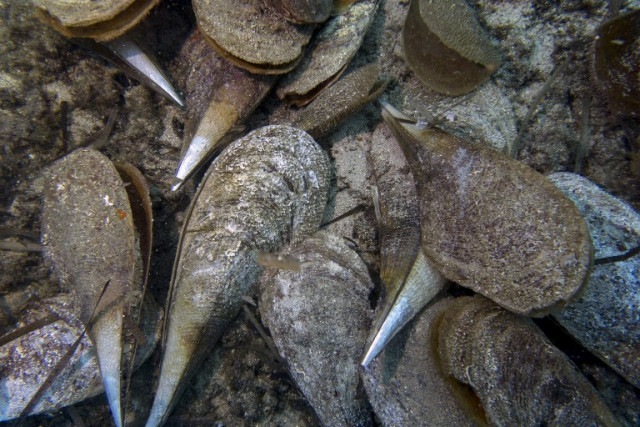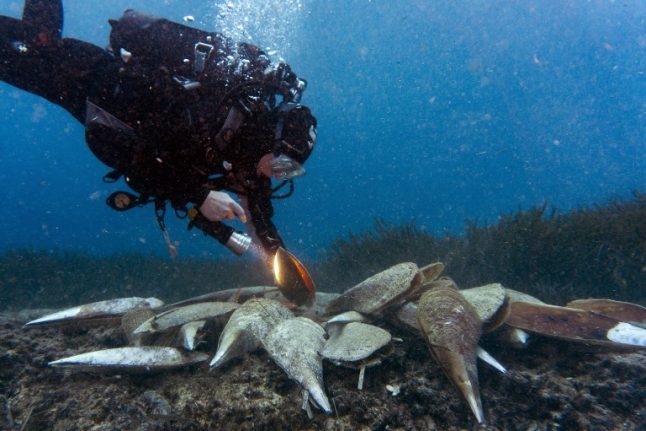But the giant mollusc, the world's second biggest, is under mortal threat from a parasite that has ravaged populations since it was identified along Spanish coasts in 2016.
Scientists fear that climate change and warming waters will intensify the devastation, which they now class as an emergency.
The noble pen shells, or Pinna nobilis, can live for up to 45 years and grow to about 1.2 metres (four feet).
They are only found in the Mediterranean Sea, standing proudly upright like ships' sails, their tips anchored in sandy seagrass meadows by sinewy fibres.
On the tranquil surface of the water at Villefranche-sur-Mer, near Nice in southern France, there is little evidence of the carnage below.
But dive down and the seafloor is a graveyard of noble pen shells.
Death has shrivelled the flesh of the molluscs and dulled the mother-of-pearl to a rusted brown inside the shells, in an area abandoned by the usual myriad of tiny cohabitors — little crabs, shrimps and orange sea fans.

Weakened, then starved
“We cannot find a living one,” said diver Olivier Jude, emerging, camera in hand, from the bay after an unsuccessful attempt to photograph the Pinna nobilis for his Phoctopus website.
The French Riviera is the latest site of the die-off, caused by the relentless assault of a new parasite that weakens the clam, quickly starving it to death.
The pathogen has almost eradicated the noble pen shell population off the Spanish coast, where it is now listed as critically endangered, and has spread to other coastal areas.
It is now attacking the clams from France to Turkey. “The situation is deeply alarming,” Maria del Mar Otero, a marine expert at the International Union for Conservation of Nature's (IUCN) Centre for
Mediterranean Cooperation, adding that the species was “on the verge of disappearing” in Spain.
'Everything was dead'
Fields of the giant molluscs clustered on the coastlines of the Mediterranean have been known to coastal communities for centuries.
In ancient times, fine threads plucked from their tufted beard-like growths were spun into sea silk, an incredibly rare gossamer material that shimmers like gold.
Some believe that this fabric fished from the sea could have been the basis for the legend of the Golden Fleece sought by Jason in Greek mythology.
Now their very existence appears to hang in the balance.
Noble pen shells are seen as an indicator of the ocean's health, recording on their long-lived shells the chemical and physical changes in the waters.
An IUCN map of the affected region, periodically updated since the beginning of the crisis, is studded with a growing number of red dots corresponding to mortality rates of above 85 percent.
The southern Spanish coast is hemmed almost entirely in crimson, while scarlet spots are also clustered around the French island of Corsica, in Italy, Turkey, Cyprus and Greece.
French marine biologist Nardo Vicente, of the Paul Ricard Institute of Oceanography, has monitored a field of noble pen shells off the coast of Corsica since the early nineties.
Nestled on the seabed between 26 and 40 metres underwater, the clams are around 30 years old and have grown to around 80 cm.
“In 2017 the field was in perfect health,” he said.
“This year, everything was dead, absolutely a hundred percent!”
Tiny assassin
The parasite, found in the digestive systems of several of the dead noble pen shells, is from the haplosporidium genus, blamed in the United States for the mass die-off of oysters in Delaware Bay in the 1950s.
It is not yet clear what brought the tiny killer to the Mediterranean or how it is spreading so fast, although it could have arrived on the hulls of merchant ships.
But the disease appears to thrive in warming waters.
Vicente said global warming was acting to stimulate “a bunch of germs, viruses and parasites” that had lain dormant but “act fully with the rise in temperature”.
The waters around the Corsican field he monitored were 20 degrees C even at 40 metres, when normally they would be 13 or 14 degrees C.
“It's completely abnormal,” he said.
He said he was “devastated” but hopes that rescue programmes will be able to re-populate the affected areas and save the species.
Racing against time
In Spain, a few noble pen shells have been preserved in aquariums — though not all survived — while Italy and France have strengthened coastal monitoring.
Lagoon areas are another source of hope, where the noble pen shells appear to be more resilient.
But as experts race against time before summer raises the water temperatures, there are fears that the noble pen shell's fate might be a warning sign for the health of the sea.
In Villefranche-sur-Mer, the coastal waters are relatively well protected with zones where boats are prohibited from dropping anchor.
Lidwine Courard, a diver with the NaturDive association, said the molluscs began to die off in October along the French Riviera.
“Some say it might be the beginning of the extinction of other species.”
By AFP's Claudine Renaud



 Please whitelist us to continue reading.
Please whitelist us to continue reading.